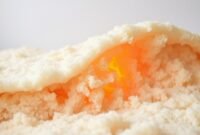Are you tired of high energy bills and uncomfortable homes? Choosing the right insulation is a big challenge. The wrong choice can cause poor insulation, more noise, and damage.
I’ll explain the key differences between rockwool and fiberglass insulation. Knowing their unique features helps you pick the best for your home. This improves comfort, energy use, and safety. Let’s dive into these two popular options.

Understanding Insulation Basics and Material Composition
Exploring home insulation options means knowing the core materials. Mineral wool insulation stands out with its unique traits. I’ll explain the key differences between Rockwool and fiberglass to help you choose the best for your home.
Read also: How Long Does Fiberglass Insulation Last
What is Rockwool Made From?
Rockwool, a mineral wool type, comes from a special process. It begins with basalt rock, heated to extreme temperatures and spun into fibers. This makes a versatile insulation product with great properties. The use of recycled materials boosts its sustainability and effectiveness.
- Primary ingredient: Basalt rock
- Manufacturing temperature: Extremely high heat
- Composition: Recycled materials and natural stone
Fiberglass Manufacturing Process
Fiberglass insulation is made differently. Glass is melted and spun into thin fibers, then combined into sheets. This method is distinct from the rock-based mineral wool process.
Core Material Differences
Mineral wool insulation has its downsides, mainly in core materials. Rockwool, made from stone, offers better fire resistance and sound dampening than fiberglass. Each material has its own strengths for insulation needs.
| Characteristic | Rockwool | Fiberglass |
|---|---|---|
| Base Material | Basalt Rock | Glass Fibers |
| Fire Resistance | Excellent | Good |
| Sound Absorption | Superior | Moderate |
Knowing these differences helps homeowners and contractors pick the right insulation. Each type offers unique benefits for various projects.
Thermal Performance and R-Value Comparison
When we talk about rockwool insulation vs fiberglass, thermal performance is key. Homeowners want to save energy. The R-value shows how well insulation stops heat from moving.
- Rockwool has an R-value of 4.0 per inch
- Fiberglass ranges from 2.2 to 3.8 per inch
- A higher R-value means better heat resistance
Rockwool insulation beats fiberglass in thermal performance. It has fewer air gaps. This means your home stays warmer or cooler, depending on what you need.
| Insulation Type | R-Value per Inch | Thermal Efficiency |
|---|---|---|
| Rockwool | 4.0 | High |
| Fiberglass | 2.2 – 3.8 | Moderate |
Climate and how well it’s installed affect thermal performance. Rockwool might have a slight edge, but proper installation is key. It ensures you get the most energy savings.
For those in very cold or hot areas, rockwool’s consistent barrier is a big plus. It keeps your home comfy and can lower your energy bills.
Rockwool Insulation vs Fiberglass: Cost Analysis and Value
Choosing the right insulation is a big decision. It involves looking at the costs of mineral wool fiberglass and traditional fiberglass. Homeowners need to understand these costs before they invest.
When looking at fiberglass mineral wool, the initial cost is key. Homeowners often see big price differences between these two options.
Initial Installation Costs
The cost breakdown shows some interesting points:
- Fiberglass insulation: $0.60 – $1.20 per square foot
- Rockwool insulation: $1.50 – $2.00 per square foot
Long-term Energy Savings
Rockwool might cost more at first, but it saves more energy. Mineral wool fiberglass keeps heat better. This can lower your heating and cooling bills over time.
Return on Investment Considerations
When thinking about ROI, consider these important factors:
- Thermal efficiency ratings
- Expected lifespan of insulation
- Local climate conditions
- Home’s existing energy performance
Insulation is a long-term investment. Rockwool’s higher initial cost might lead to more savings and better home comfort later on.
Fire Resistance Properties

Fire safety is key when choosing insulation for your home. Wool insulation, like Rockwool, is a top pick for fire protection. It can handle temperatures over 2,000°F, acting as a strong barrier against fires.
Fiberglass mineral insulation also has some fire resistance. But it can’t compare to Rockwool. Fiberglass starts to melt at about 1,100°F. This shows how wool insulation offers better protection.
- Rockwool: Withstands temperatures up to 2,000°F
- Fiberglass: Begins to melt around 1,100°F
- Rockwool acts as a natural fire barrier
Building codes and insurance companies often prefer materials with strong fire resistance. Rockwool’s high performance means it can give extra minutes of protection during a fire. This could save lives and reduce damage.
For those who value safety, wool insulation is the best choice. Rockwool’s ability to resist high temperatures makes it a top pick for maximum security and peace of mind.
Sound Dampening Capabilities
When comparing rockwool insulation vs fiberglass, sound dampening is key. Homeowners and professionals look for ways to reduce noise. Fiberglass insulation absorbs sound a bit, but rockwool insulation is better at it.
Sound performance depends on material density and structure. Rockwool’s special mix makes it better at blocking noise.
Read also: The Best Insulation for Bathroom Walls Interior
Noise Reduction Coefficients Explained
Noise reduction coefficients (NRC) show how well insulation absorbs sound. Rockwool usually has higher NRC ratings than fiberglass insulation.
- Rockwool NRC: 0.85-1.05
- Fiberglass insulation NRC: 0.50-0.75
Read also: 3 Blown In Fiberglass Insulation Problems
Ideal Soundproofing Applications
Rockwool insulation is great for places where sound control matters a lot. It’s best for areas needing top-notch sound management.
| Location | Rockwool Performance | Fiberglass Performance |
|---|---|---|
| Home Theater | Excellent | Good |
| Shared Walls | Superior | Moderate |
| Recording Studios | Exceptional | Limited |
For serious soundproofing, rockwool insulation is the best choice. It works well in both homes and commercial spaces.
Moisture Resistance and Mold Prevention
Choosing the right insulation is key to its long-term success. Mineral wool insulation is a top choice for handling moisture issues in buildings.
Mineral wool insulation has special properties that make it great at keeping water out. It doesn’t absorb water like other insulations do. This means it can stop mold and mildew from growing. It’s perfect for places that are often damp or where water might get in.
- Naturally water-repellent composition
- Prevents mold and mildew development
- Maintains insulation effectiveness in damp conditions
- Reduces risk of structural damage from moisture
One downside of mineral wool insulation is it costs a bit more at first. But, its ability to resist moisture can save money in the long run. It helps avoid damage from water.
| Moisture Resistance Characteristic | Mineral Wool Insulation | Fiberglass Insulation |
|---|---|---|
| Water Absorption Rate | Low (Hydrophobic) | Moderate |
| Mold Growth Potentia | Minimal | Higher Risk |
| Performance in Humid Environments | Excellent | Reduced Effectiveness |
For those looking for reliable insulation against moisture, mineral wool is a strong choice. It keeps moisture out well, ensuring it lasts long and works well in different conditions.
Installation Process and Handling Differences
Choosing between rockwool insulation and fiberglass is key for homeowners and contractors. Each has its own challenges and benefits during installation.
Rockwool insulation is harder to install than fiberglass. It needs special handling. Fiberglass, on the other hand, is easier to set up.
Essential Tools for Installation
- Fiberglass insulation vs rockwool demands different cutting tools
- Protective safety gear is mandatory for both materials
- Specialized equipment needed for precise rockwool cutting
Installation Complexity Comparison
| Characteristic | Rockwool Insulation | Fiberglass Insulation |
|---|---|---|
| Cutting Difficulty | High (requires serrated knife) | Low (easily cut with utility knife) |
| Flexibility | Rigid | Highly flexible |
| Installation Time | Longer | Quicker |
Safety Considerations
When working with insulation, safety is top priority. Rockwool needs more protective gear because it’s dense. Always wear masks, safety glasses, and long sleeves to avoid health risks.
Experts say to handle insulation carefully and ensure good ventilation. Knowing these differences helps you choose the right insulation for your project.
Environmental Impact and Sustainability
Choosing the right insulation is key to the environment. My study shows big differences between fiberglass mineral wool and mineral wool fiberglass in how green they are.
Rockwool shines with its green credentials. It’s made from about 70% recycled stuff, cutting down on waste and using fewer resources. On the other hand, regular fiberglass only has 20-30% recycled parts.
- Rockwool recycles industrial waste during manufacturing
- Fiberglass production requires more virgin raw materials
- Both materials can be partially recycled at end of life
Rockwool’s making process uses less energy than fiberglass. This means it makes fewer carbon emissions during production.
Choosing insulation is more than just about how well it works. The planet’s health matters too. Rockwool’s focus on being eco-friendly makes it a top pick for those who care about the environment.
By picking insulation with more recycled stuff and less energy use, we can help the planet. This choice is good for our planet and for us.
Durability and Lifespan Expectations
Choosing the right insulation for your home is key. Knowing how well wool and fiberglass insulation last is important. This affects your energy use, comfort, and upkeep costs.
Insulation types last different lengths of time and need different care. Rockwool wool insulation often lasts longer than fiberglass mineral insulation.
Material Lifespan Comparison
I looked into how long different insulations last. Here’s what I found:
- Rockwool wool insulation: About 30-40 years
- Fiberglass mineral insulation: About 25-30 years
Degradation Factors
Several things can affect how well insulation works over time:
| Degradation Factor | Rockwool Impact | Fiberglass Impact |
|---|---|---|
| Moisture Exposure | Little damage | High risk of mold/compression |
| Settling | Resists compression well | Prone to settling |
| Temperature Fluctuations | Keeps shape well | More likely to break down |
Maintenance Requirements
Rockwool wool insulation needs little upkeep compared to fiberglass. Its dense structure stops it from sagging. It also keeps its thermal performance and stands up to the environment better.
When picking insulation, think about how long it lasts. This affects your energy use and home comfort over time.
Read also: R49 Batt Insulation: Best Home Comfort Solution
Common Applications and Best Use Cases

Choosing between rockwool and fiberglass insulation depends on your project needs. Both types have unique benefits for different parts of your home.
Fiberglass insulation is great for most homes. It works well in:
- Attic spaces
- Interior wall cavities
- Garage insulation
- Standard residential construction
Rockwool insulation is better for special needs. It’s perfect for:
- Exterior wall systems
- Basement waterproofing
- High-moisture environments
- Soundproofing projects
Fiberglass is easy to install and affordable. Rockwool, on the other hand, is durable and performs well in tough spots.
When picking between rockwool and fiberglass, think about your project, climate, and budget. This will help you choose the right insulation for your needs.
Conclusion
Exploring mineral wool insulation and fiberglass, I found both have their benefits for home insulation. Mineral wool shines with its fire resistance and sound dampening. Yet, it has some downsides that homeowners need to think about.
Choosing the right insulation isn’t simple. Budget, project needs, environment, and personal goals matter a lot. Some homes might prefer mineral wool’s moisture resistance, while others might choose fiberglass for its cost.
Homeowners should do a detailed check of their needs. Look at thermal performance, installation costs, energy savings, and environmental effects. Getting advice from experts can guide you in picking the best insulation for your home.
In the end, Rockwool and fiberglass are top choices for insulation if installed right. Your home’s comfort, energy use, and safety depend on a well-informed decision that fits your needs.


